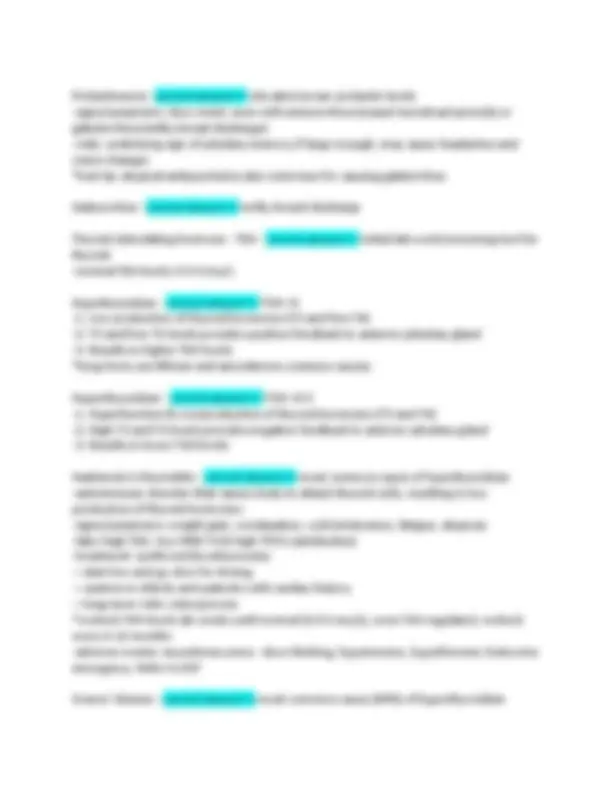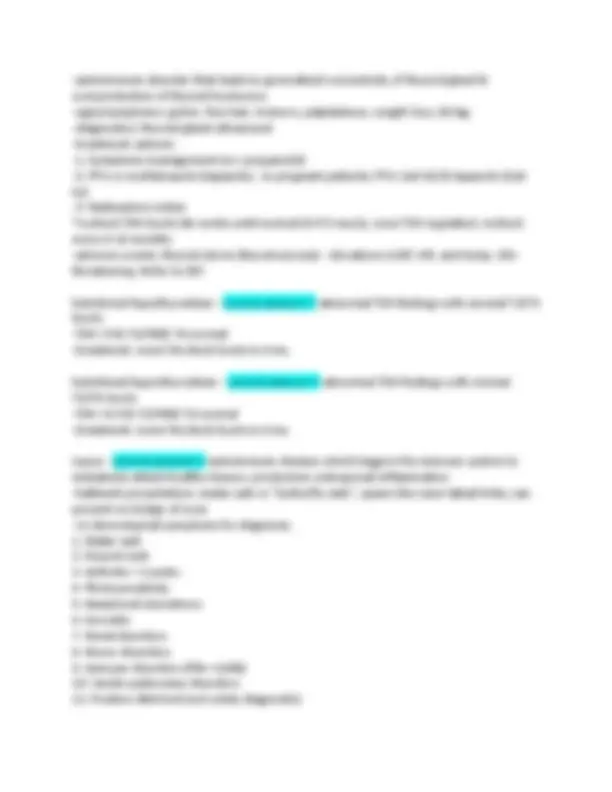







Study with the several resources on Docsity

Earn points by helping other students or get them with a premium plan


Prepare for your exams
Study with the several resources on Docsity

Earn points to download
Earn points by helping other students or get them with a premium plan
Community
Ask the community for help and clear up your study doubts
Discover the best universities in your country according to Docsity users
Free resources
Download our free guides on studying techniques, anxiety management strategies, and thesis advice from Docsity tutors
Hypothalamus - correct answer>>-sends "releasing hormone" signals -TRH, GNRH, GHRH, CRH, & somatostatin Negative feedback system - correct answer>>-low levels = stimulates production -high levels = ceases production Anterior pituitary - correct answer>>-follicle stimulating hormone (FSH): ovaries, eggs & estrogen development -thyroid stimulating hormone (TSH): thyroid gland, T3 & T4 -growth hormone (GH): somatic growth of body -prolactin: lactation & breast development -adrenocorticotropic hormone (ACTH): adrenal glands, cortisol & aldosterone -luteinizing hormone (LH): ovulation, progesterone & testosterone -melanocyte stimulating hormones (MSH): melanin production (in response to UV light) Posterior pituitary - correct answer>>-antidiuretic hormone (ADH): promotes water retention at the kidneys -oxytocin: uterine contractions & breast milk ejection Follicle-stimulating hormone (FSH) - AP - correct answer>>-ovaries, eggs & estrogen
Typology: Exams
1 / 9

This page cannot be seen from the preview
Don't miss anything!






Hypothalamus - correct answer>>-sends "releasing hormone" signals
Antidiuretic hormone (ADH) - PP - correct answer>>-promotes water retention at the kidneys Oxytocin - PP - correct answer>>-uterine contractions & breast milk ejection Parathyroid glands - correct answer>>-sit on the back of the thyroid
not necessary to memorize for the exam, but understand there are many diagnostic symptoms apart from just a positive ANA test!
Metformin 500mg BID—>(if hgbA1c >7% after 3 months)—>Metformin 1000mg BID— (if hgbA1c >7% after 3 months)—>Metformin 2500mg daily (max dose)—>(if hgbA1c still >7% ADD ON DIFF DIABETES MED CLASS TO REGIMEN!! Insulin - correct answer>>R ("ready") — rapid (humalog) — 15 min onset — 1 hour peak — 2 - 4 hour duration S ("set") — short (regular) — 30 min onset — 2 - 4 hour peak — 8 hour duration I ("inject") — intermediate (NPH) — 2 hour onset — 8 hour peak — 16 hour duration L ("love") — long (levimir/lantus) — 2 hour onset — no peak! — 24 hour duration *start insulin if HgbA1c is >9% (also pregnancy safe)